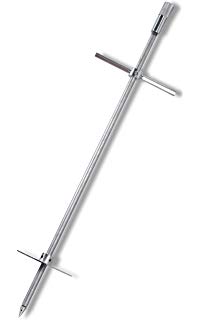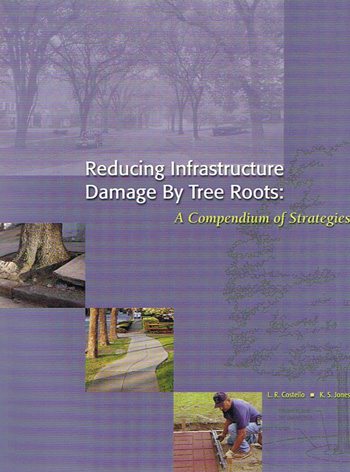
Air excavation has become a preferred method for digging on many jobs ranging from utility work to advanced tree care. Excavating with the AirSpade offers a number of advantages over conventional tools such as picks, shovels, and backhoes, including:
- Two to three times faster than hand excavation.
- Less worker fatigue than a pick or shovel.
- Eliminates sharp metal edges as featured on picks, digging blades, or buckets.
- Harmless to buried, solid objects such as utility lines, telecommunication cables, tree roots, hazardous waste containers, or military ordnance.
- Excavates some rocky soils where a shovel is difficult to use.
- Breaks soil into small particles that are ideal for re-compaction.
- Powered by common, tow-behind air compressors
The AirSpade Supersonic Nozzle
Soil is an unconsolidated assemblage of solid particles including clay, sand, silt, and rock, and sometimes organic matter. Voids between the particles are occupied by air and/or water. When compressed air is directed into soil at close range, air enters the voids, expands, and fractures the soil. Stronger, non-porous materials such as metal or plastic pipes, cables, or even tree roots are unaffected.
AirSpade’s proprietary, supersonic nozzle turns compressed air into a high-speed, laser-like jet moving at twice the speed of sound, Mach 2. All of the energy and momentum of air moving at approximately 1,200 mph is focused onto the soil, dislodging it in a fraction of a second. Although rocket engine exhaust nozzles with supersonic performance have been in use for many years, supersonic air-excavation nozzles are a relatively new development. Through in-depth aerodynamic research including analysis of high-speed movies, combined with extensive knowledge of soils, AirSpade designed and developed the proprietary supersonic nozzle (US Patent #5,782,414).
Unlike propulsion nozzles, energy harnessed to accelerate the air stream comes from the expansion of air under compression rather than from the combustion of fuel. Adding to the challenge are issues relating to the effect of the air flow boundary layer on the nozzle profile. In order to meet demanding specifications and tight tolerances required, special tooling and computer-aided-machining is used to manufacture the nozzle. AirSpade continues to refine and improve the supersonic nozzle design through detailed mathematical modeling and laboratory experimentation.
Compressed Air Requirements
All AirSpade nozzles are designed to operate optimally at 90 psi and are manufactured in different sizes (air flow rates) to match standard, commercially available compressors (see table below). Note that a smaller nozzle may always be used on a larger capacity compressor, but not the reverse. Running a nozzle with a higher flow rating than the capacity of the compressor will result in a significant pressure drop (less than 90 psi at the nozzle) and will noticeably diminish performance.

Digging with AirSpade
Featuring the patented, supersonic nozzle, AirSpade is effective in virtually all soils and even hard clays. Under normal conditions, AirSpade will dig a trench up to several inches deep per pass, in medium to stiff soil.
In general, AirSpade will not cut through rock. However, shale may be broken apart by the AirSpade if the air-jet is directed between the laminations of the rock. Typically, AirSpade will not dislodge hard, frozen soils which tend to behave like pavement or concrete.
Watering the work area ahead of time can sometimes be helpful. Water reduces soil strength thus making digging easier. Water also reduces airborne dust if the soil is extremely dry. Combining the use of the AirSpade with a low-pressure water source (garden hose) can aid the excavation of highly compacted or sun-baked soils.
Excavation Rates
Excavation rates for AirSpade are a function of soil type and nozzle size (air flow). Hard, stiff soils will have lower excavation rates than soft, sandy soils. For any given soil, the lower the unconfined compressive strength, the faster the digging.
As shown in the table below, six standard AirSpade supersonic nozzles, ranging in size from 25 cfm to 330 cfm, are available. As a rule of thumb, the quantity of soil that can be excavated in a given amount of time is roughly proportional to air consumption.
Technical Applications
Urban Tree Soil Replacement
This application is ideal for tree plantings with root zones extending underneath pavement and those that have poorly suited or limited soil or where pavement is proposed to be added or replaced within an existing root zone. Similarly, this may be applied to trees planted in high-use lawn areas (for example within parks or campus landscapes,) where soil replacement is desired to improve lawn durability and health.
Bare Rooting and Transplanting
Bare rooting is a procedure used to relocate or remove soil around existing trees. Use of an AirSpade for bare rooting is the best way to minimize damage to the tree’s root system and the most efficient technique available. Bare rooting with an AirSpade can also be applied to perennial, shrub, and groundcover plantings. This is a preferred method of transplanting plant material because of its efficiency and ability to preserve fine root systems. Furthermore, bare rooting small plants is often
required during more extensive root zone treatments (such as aeration and decompaction) or other site work applications.
The oversight of a certified arborist is critical during bare rooting. While use of an AirSpade can significantly reduce trauma to the tree, it is important to monitor the tree’s health and care before, during, and after the procedure. Supplemental watering is typically necessary and should be provided with direction and continued monitoring from the arborist.
Root Pruning
Construction or maintenance work that makes intrusions into a tree’s root zone will benefit from use of an AirSpade. Air-spading is safe to the tree’s roots and a highly efficient method to perform exploratory excavation to locate existing roots and utilities. Almost any site work operations – including the building of foundations, pavements, drainage infrastructure, and utilities – present ideal opportunities for air-spading and root pruning.
Root Collar Excavation
Trees commonly suffer when the grade is set too high against their root flare or root collar. This can occur when trees are planted at the wrong elevation or when trees subside due to improper compaction below the root ball when they are planted. Alternatively, root collars can be buried over time due to the accumulation of mulch or soil around the tree.
Whatever the cause, harm to the tree from grade set above the root collar can be long lasting and should be remediated through root collar excavation with an AirSpade. Symptoms of this condition include rot or infection of bark at the base of the trunk, growth of roots that are too high relative to the natural root flare, and girdling roots, which constrict the root flare and tree trunk. Use of an AirSpade allows tree root collars and girdling roots to be excavated with minimal damage to the tree. Once
uncovered, a certified arborist can easily identify roots that need to be removed or trained.
Vertical Mulching
Vertical mulching with AirSpade is done to de-compact and augment soil deep into the tree root zone. This application is especially useful in areas with poor drainage, with shallow or impervious soils, or shared by perennial or ground-cover plantings, where minimal disturbance is desired.
Radial Trenching
Radial trenching with AirSpade is done to modify soil composition, improve aeration, and encourage root growth to moderate depths (typically 10”-12” or more), and is especially effective when trees have highly stratified or shallow depth of viable soil or anaerobic conditions. Additionally, this application can be useful in planting areas where minimal disturbance is desired.
Air Tilling (Root Invigoration)
Trees and shrubs suffering from shallow soil compaction (typically due to pedestrian use or vibrations caused by vehicular traffic), or lacking vigorous root growth due to poor topsoil quality (lack of organic matter, nutrients, beneficial organisms, or aeration) are ideal candidates for air tilling. Since most of a tree’s roots proliferate near the surface where they have the best access to oxygen and nutrients, air tilling is excellent at promoting robust and uniform root growth.
Where to Buy
Visit treelogictools for all your AirSpade needs.
 |  |  |  |








